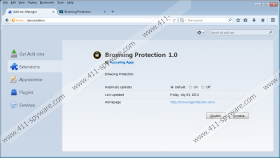Browsing Protection Removal Guide
Browsing Protection is an application that claims to be able to protect your system from different kinds of harmful applications that are just waiting for the opportunity to enter your system. Thus, it is not surprising that computer users consider this program beneficial. Unfortunately, not everything is so perfect about Browsing Protection, which is why we do not recommend trusting it completely, especially if it has entered your system without your direct permission. Luckily, the removal process is not difficult at all because this software can be erased via Control Panel. Do you still need some additional guidance? If so, you are free to use the instructions provided below the article.
The research carried out by the specialists of 411-spyware.com has shown that Browsing Protection is a typical advertising-supported application because it is going to flood your Internet Explorer, Google Chrome, and Mozilla Firefox browsers with various commercial advertisements. If you read End User License Agreement (EULA) attentively, you will definitely notice that you are going to see sponsored links, banners, coupons, video-targeted ads, and the like. There are no doubts that all these applications will appear on your screen; thus, it is very likely that your browsing processes will be disrupted. The deletion of Browsing Protection is the only way to stop them from appearing, which is why we suggest that you get rid of it as soon as possible. If you do so, you will also reduce the possibility to infect your system because it is very likely that links embedded into ads are not reliable.
What is more, Browsing Protection will start performing other suspicious activities after the infiltration on your system. For instance, it is going to connect to the internet without your permission and might even record some of the information associated with your activities on the web. According to the information provided on the official website (browsingprotection.com), your search queries, browsing history, browser type, the version of the OS, and other similar data will be collected. For this matter, data tracking technologies (e.g. cookies) will be used. It does not seem that this software is interested in personal data; however, if you still do not like how it acts, you can get rid of it whenever you want to.
The easiest way to remove Browsing Protection from the system is to scan PC with a reputable malware remover; however, you can also delete it manually by using the instructions provided below the article. If you have decided to erase this advertising-supported application manually, you should know that it is still important to scan the system with a reliable scanner in order to check whether there are no other serious infections residing on your system. Click on the Download button below the article and you will be able to download a free SpyHunter scanner.
How to get rid of Browsing Protection
Windows 8
- Tap the Windows key + R.
- When RUN launches, type in control panel and then click OK.
- Select Uninstall a program.
- Locate and right-click on the undesirable software.
- Select Uninstall to remove it.
Windows 7 and Vista
- Click the Start button.
- Select Control Panel.
- Click Uninstall a program.
- Find the suspicious program on the list. Select it.
- Click Uninstall.
Windows XP
- Navigate to the left corner of your screen.
- Click on the Start button.
- Select Add or Remove Programs.
- Select Browsing Protection from the list of applications.
- Click Remove to delete it.
Browsing Protection Screenshots:




